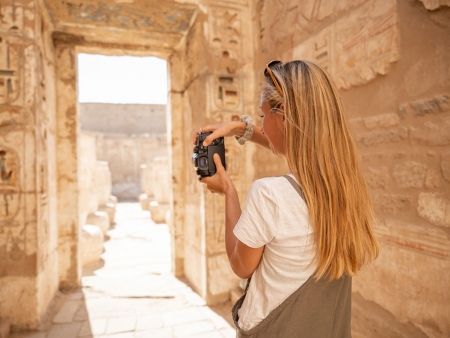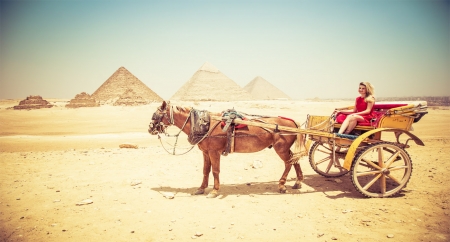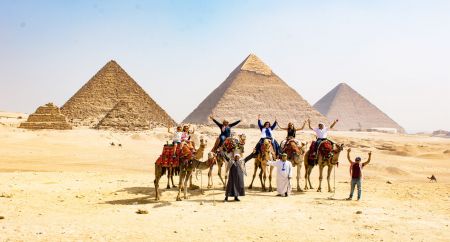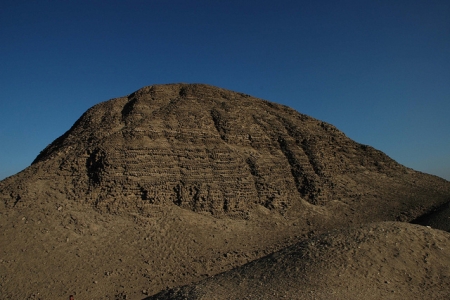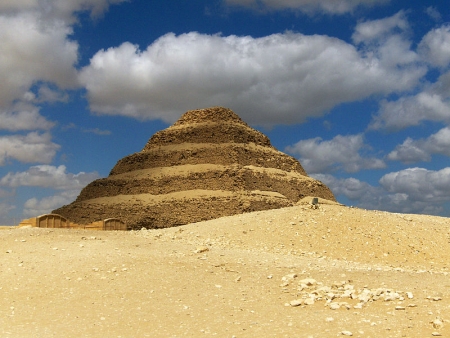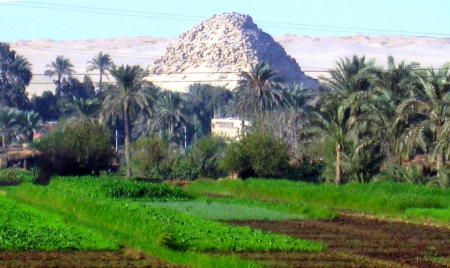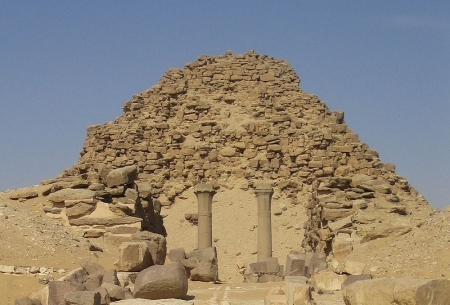Abu Sir | Egyptian Necropolis & Pyramids

ABU-SIR, an archaeological locality on the western bank of the Nile River, approximately 25kilometers ( 15 miles) southwest of Cairo.
It is a part of the necropolis of ancient Memphis consisting of several pyramids of the fifth Dynasty (2494-2345 BC), a sun temple and a number of mastaba tombs and Late Period (747-332 BC) shaft tombs. Its name was derived from the Egyptian Per-Usire, in Greek .Busiris, Meaning "the place of worship or the god Os iris." ruler of the land of the dead .
Abusir is one relatively small segment of the extensive "pyramid field" that extends from north of Giza to below Saqqara, the locality of Abusir took its turn as the focus of the prestigious western burial rites operating out of the then-capital of Memphis during the Old Kingdom fifth Dynasty.
Although Abusir had already been inhabited by hunters in the Middle Paleolithic and was settled in the Neolithic, it became especially important in the fifth dynasty. When the first ruler. Userkaf (ruled c.2513- 2506 BCE), built the sun temple Nekhen-Re there and Hatshpsut. At least four of his successors (Sahura, Neferirkara,Ran eferef and Nyuserra) therefore chose Abusir as the location for their funerary monuments.
1-Sahura ‘s pyramid:-<
Sahura was the first to build himself a pyramid complex that is regarded as a milestone in the development of royal tombs; the dimensions of his pyramid are smaller than those of the forth dynasty pyramids, but his mortuary and valley temples achieved greater importance
The funerary monument of Sahura (2487-2475 Bc), the most complete of the four royal burials at Abusir, is the quintessential fifth Dynasty pyramid complex, consisting of valley temple, causeway, mortuary temple and pyramid. The imposing portico of the mortuary temple gave access to a large courtyard with a well-preserved basalt-paved floor and a colonnade consisting of sixteen red granite palm columns (the latter now largely destroyed).
The remains of the original limestone walls, with their fine painted decoration, have been transferred to the Egyptian Museum in Cairo and the Bode museum in Berlin.The mortuary lemple was designed with finely worked building materials: red granite was used for the palm columns that stood in an open court; walls or
whitc limestone were decorated with superb polychrome scenes in low relief which mainly showed mythical scenes of the ruler victorious in battle against Egypt's traditional enemies: hunting scenes; and ships.
Beyond the colonnade were a series of store rooms surrounding the 'statue chamber', where the king statues stood in niches, and immediately adjacent to the pyramid was the sanctuary with its alabaster altar.Sahure's valley temple on the edge of the desert served as a landing place, linked to the Nile by a canal. A causeway led from this temple to the mortuary temple; some fragments of the causeway’s relief decoration included scenes of the complete on celebrations buildings, starving Bedouins and other scenes.
2-Neferirkara ‘s Pyramid :-
The pyramid complex of Sahure's successor, Neferirkara (ruled c.2492-2482 BeE), was located on the most elevated site in the cemetery. The pyramid, which was changed in the course of construction from a stepped into a true pyramid. rose to a height of approximately 74 meters (225feet).
The casing was however, left unfinished, like the remaining pal1s or the complex, as a result of the rulers premature death . His motuary temple was constructed of mud bricks and wood by his sons and heirs, Neferirkara and Newoserra .
At the end of the nineteenth century tomb robbers discovered a papyrus archive (called the first Abusir Archive) in the storage rooms of the• mortuary temple.The papyri date from the reign of Issesi to that of Pepi II , and mainly consist of rotas for temple personnel, inventories of cult objects, and letters. . These record date from the last part of the fifth dynasty to the end of the sixth.
Neferirkara's causeway was evidently usurped by Nyuscrra, who diverted it to his own mortuary temple.On the southem side of Neferirkara 's pyramid is smaller pyramid complex of his wife,Khentkawes II .Valuable finds from the queen's mortuary temple have included numerous papyrus fragments (the Second Abusir Arc hive) and other materials that throw new light on complex problems related to the emling of the fourth dynasty and the beginning of the fifth-in particular.
the role played by the two queen mothers. Khentkawes I and Khentkawes II.
3- Neferefre ‘s Pyramid:-
Neferirkare eldest son Neferefre ruled for only a brief period, perhaps two years, His unfinished pyramid was changed into a mastaba, and before its eastern side. An architectural unique mortuary temple was built of mud bricks.
The finds there have included stones tall fragments of the ruler, as well as pepi II from yet another temple archive (The third Abusir Archive). Roughly the same age as the Second Abusir Archive.
A cult abattoir, known as "the Sanctuary of the Knife." was connected with that mortuary temple. Fragments of pyramid foundations have been uncovered between Sahure's pyramid and Userkar’s sun temple (and those have been hypothetically attributed to Neferefre's ephemeral successor).
Customize Your Dream Vacation!
Get in touch with our local experts for an unforgettable journey.
Plan Your Trip4- Newoserre’s Pyramid:-
To remain near his family. The next fifth dynasty ruler, Newoserra .He built his pyramid at Ihe northeastern corner of the pyramid of Neferirkare. Appropriating the unfinished foundations of its valley temple and a part of its causeway for his own complex, The open courtyard of Newoserre any's mortuary temple was adorned with Papyrus-form columns of red granite, with relief decoration that in many respect resembled that of Sahure; but the normal. rectangular temple plan had to be abandoned in favor of an L- shaped outline for lack of space.Newoserre any's wife.
Repulnub,does not appear to be buried in the vicinity of her husband's tomb. Her tomb may be one of the pyramid complexes (marked (no.XXIV' and -no. XX on the Lepsius archaeological map)that were demonstrably constracted in that time.
Excavations in pyramid 24 ("no. XXIV) Have provided valuable information about its mode or construction, but the name of its owner remains unknown. Newoserre Any's successor, Mekauhor, abandoned the Abusir necropolis.
Other members of the royal family and countiers and officials of that time were also buried in the vicinity of the pyramids. The largest of their tombs belonged to the vizier Ptahshepses.N ewoserre Any's son-in-Iaw; that twice extended mastaba almost rivaled the royal complexes in size.
Architectural plan and quality of decorative relief. Its eight stemmed lotus form columns of fine limestone a unique. at far &on this is the mastaba of the princesses Khnmeremebt and Meretites, two daughters of Newoserre Any. Nearby are the mastabas of the princesses 0Khekeretnebty and Hetjetnub, daughters of Isesi.
During the First Intermediate Period. There were no royal mortuary cults at Abusir. Although brieny revived at the beginning of the Middle Kingdom. From this period to the late period, Abusir became increasingly a cemetery for the common people.
A cemetery in southwestern Abusir was built to contain huge shaft tombs that were dated to the end of the twenty sixth dynasty and the beginning of the twenty seventh Among them was the tomb of Udjahorresnet. Chancellor of Egypt Persian kings. Cambyses and Darius ( (of the Firs t Persian occupation). His tomb was constructed with a cunning system of linked shafts, filled with sand: this was supposed to prevent access to the burial chamber.
The southwestern excavation also uncovered the intact tomb of lufaa, director' of the palace.
The history of archaeological research in Abusir, in which Germans, French. Swiss, Egyptians and Czechs have participated, began in the 1830s. Yet only two expeditions have earned out long term and extensive excavations there- that of the German Oriental Society.
Headed by Ludwig Borchardt , from the beginning of the twentieth century and the ongoing expedition of the Czech Institute of Egyptology, which began in the 1960s
References :-
1. Donald B. Redford, Oxford Encyclopedia of Ancient Egypt, Vol.1, Oxford University Press, Inc., Berlin, 2001.
2. Ian Shaw and Paul Nicholson, The British Museum Dictionary Of Ancient Egypt, The American University in Cairo, 2002.


